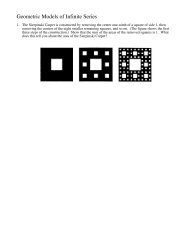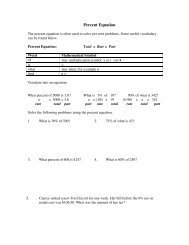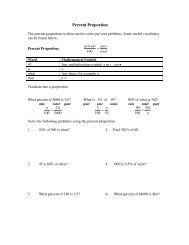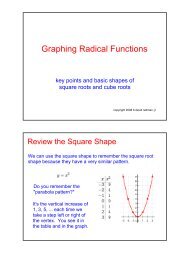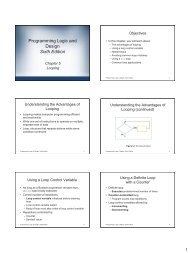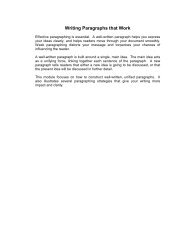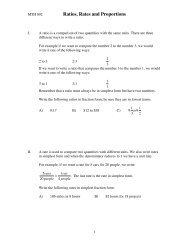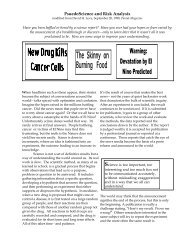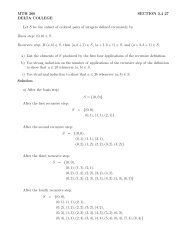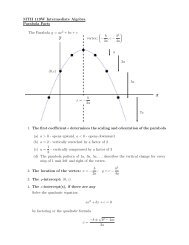Programming Logic and Design Sixth Edition
Programming Logic and Design Sixth Edition
Programming Logic and Design Sixth Edition
You also want an ePaper? Increase the reach of your titles
YUMPU automatically turns print PDFs into web optimized ePapers that Google loves.
Underst<strong>and</strong>ing the Three Basic<br />
Structures (continued)<br />
Underst<strong>and</strong>ing the Three Basic<br />
Structures (continued)<br />
• Structured programs have the following<br />
characteristics:<br />
– Include only combinations of the three basic structures<br />
– Each of the structures has a single entry point <strong>and</strong> a<br />
single exit point<br />
– Structures can be stacked or connected to one<br />
another only at their entry or exit points<br />
– Any structure can be nested within another structure<br />
Figure 3-9 Flowchart <strong>and</strong> pseudocode for loop within selection within<br />
sequence within selection<br />
<strong>Programming</strong> <strong>Logic</strong> & <strong>Design</strong>, <strong>Sixth</strong> <strong>Edition</strong> 19<br />
<strong>Programming</strong> <strong>Logic</strong> & <strong>Design</strong>, <strong>Sixth</strong> <strong>Edition</strong> 20<br />
Using a Priming Input to Structure<br />
a Program<br />
• Priming read (or priming input)<br />
– Reads the first input data record<br />
– Outside the loop that reads the rest of the records<br />
– Helps keep the program structured<br />
• Analyze a flowchart for structure one step at a time<br />
• Watch for unstructured loops that do not follow this<br />
order<br />
– First ask a question<br />
– Take action based on the answer<br />
– Return to ask the question again<br />
<strong>Programming</strong> <strong>Logic</strong> & <strong>Design</strong>, <strong>Sixth</strong> <strong>Edition</strong> 21<br />
Using a Priming Input to Structure<br />
a Program (continued)<br />
Figure 3-15 Structured, but nonfunctional, flowchart of number-doubling<br />
problem<br />
<strong>Programming</strong> <strong>Logic</strong> & <strong>Design</strong>, <strong>Sixth</strong> <strong>Edition</strong> 22<br />
Using a Priming Input to Structure<br />
a Program (continued)<br />
Figure 3-16 Functional but unstructured flowchart<br />
<strong>Programming</strong> <strong>Logic</strong> & <strong>Design</strong>, <strong>Sixth</strong> <strong>Edition</strong> 23<br />
Using a Priming Input to Structure<br />
a Program (continued)<br />
• Priming read sets up the process so the loop can be<br />
structured<br />
• To analyze a flowchart’s structure, try writing<br />
pseudocode for it<br />
start<br />
get inputNumber<br />
while not eof<br />
calculatedAnswer = inputNumber * 2<br />
print calculatedAnswer<br />
get inputNumber<br />
endwhile<br />
stop<br />
<strong>Programming</strong> <strong>Logic</strong> & <strong>Design</strong>, <strong>Sixth</strong> <strong>Edition</strong> 24<br />
4



